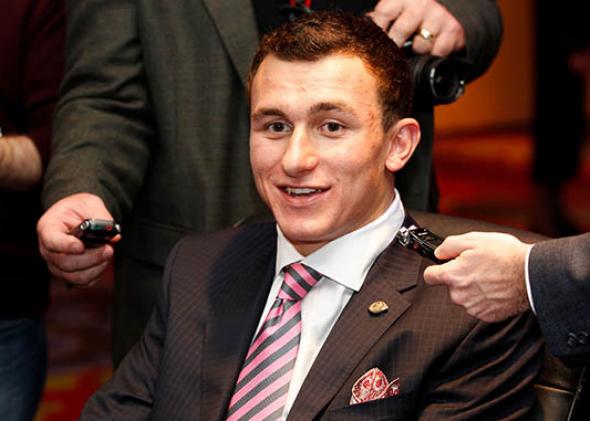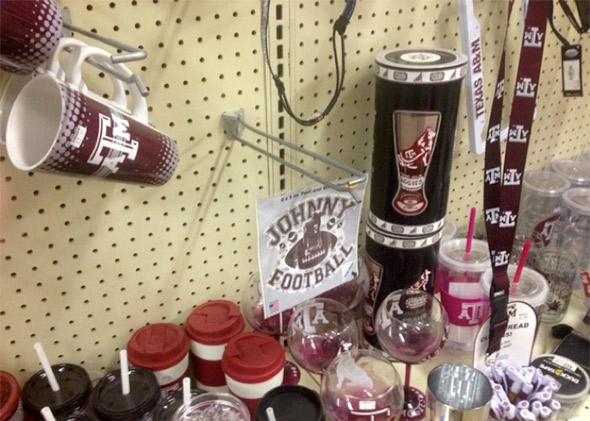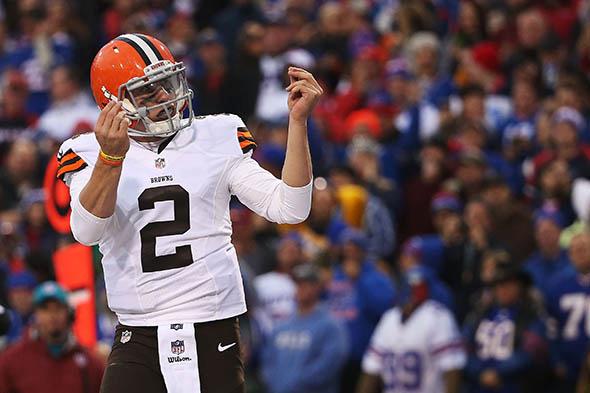From mid-September through most of November, Johnny Manziel accomplished something totally unexpected: He disappeared. Sure, during that time the Cleveland Browns quarterback offered to “mentor” fellow Heisman Trophy winner Jameis Winston, was criticized for laughing on the sidelines when his team was losing, and suggested the NCAA allow players to charge money for their autographs. But given Johnny Football’s history, this pretty much constituted a media blackout.
This is a guy who, in the two-plus years he’s been a figure of national renown, posed for a shirtless mugshot after getting arrested for his part in a bar fight, was allegedly kicked out of a frat party at a rival school, and had his parents publicly fret that he had a drinking problem. He was suspended for the first half of a game at Texas A&M for selling his signature only to return and flash the money sign after scoring a touchdown in the second half. Reports emerged that he showed up late to Peyton Manning’s football camp because he was hungover (Manziel denied it), and he was photographed in a Las Vegas bathroom rolling up money the way one might for, er, recreational use.
In the midst of all this, Manziel found time to become the most exciting quarterback in college football, win the Heisman, and get picked in the first round of the NFL draft. On the other hand, he lasted until the 22nd pick, with one anonymous scout telling Bleacher Report’s Mike Freeman that “he was paying for being a cocky asshole.” Prior to the draft, a poll claimed that 70 percent of Browns fans didn’t want the team to pick Manziel. A few months later, before he’d taken a single snap, he had the NFL’s best-selling jersey. That’s Johnny Manziel: You either can’t help but love him or you want him as far away from your team as possible.
For a few months, though, the NFL’s most polarizing player was sitting on the bench, not doing anything that anyone might have an opinion about. That changed a couple of weeks ago. First, Manziel was involved in some kind of hotel scuffle. While a police report describes a “riot” with 20 people involved, Manziel said he was out to dinner with his mom when he was accosted by an unruly fan. Then, this past weekend in Buffalo, New York, Johnny Football came on in relief of a struggling Brian Hoyer, scoring on a scrambling 10-yard touchdown run on his first NFL drive. The Browns lost, and Cleveland coach Mike Pettine has declared that Hoyer is still the starter. But Manziel is back in the mix, and back at the center of a controversy, albeit this time an on-field one.
Manziel is easy to defend. He’s a 21-year-old enjoying himself in the way 21-year-olds do. He hasn’t broken any laws—or at least he hasn’t broken that many laws—and his decision-making hasn’t seemed to affect his level of play. Considering everything that’s wrong with football in general and the NFL specifically, Manziel’s antics might seem harmless, almost quaint.
That’s the argument I expected to hear when I drove down to Kerrville, Texas, in August to see where the legend of Johnny Football began. Manziel moved to this city of roughly 23,000 people, an hour north of San Antonio, when he was in middle school. A few years later, before the rest of America had heard his name, he put together one of the best seasons in the history of Texas high school football. The man asked to save the Cleveland Browns from mediocrity, the first player to win the Heisman Trophy in his freshman season, learned the game in Kerrville.
Before I got to town, I assumed I’d find the most passionate Johnny Football fans on Earth. A 10-foot-high bronze statue didn’t seem out of the question. But that’s not what I found.
* * *
I caught Karla Dietz in her last week working at the Kerrville Visitor Center. Dietz, who has the friendly, straightforward demeanor of Friday Night Lights’ Tami Taylor, told visitors about the various museums and outdoor activities that Kerrville has to offer. Handing out bits of Johnny Manziel trivia was not part of her job description.
“He wasn’t a local,” Dietz said. “He came to go to school and to play football and he got out.”
The Manziels moved to Kerrville in the mid-2000s, and Johnny went off to Texas A&M in 2011. Now, there are no Manziels left in town. Driving into Kerrville, there is no “Home of Heisman Winner Johnny Manziel” sign. “[Locals] aren’t necessarily stuck in their ways, but they are totally OK with the way the town is,” Dietz told me. “They don’t care about [his] fame or fortune. They want Kerrville to be known for other things.”
As Dietz discussed the years when Manziel played for Tivy High, her co-worker chimed in. “I heard he was a jerk,” she said on her way back from the copy machine. “My son-in-law went to school with him.” She then went back to typing on her computer.
“I truly believe if he had been born and raised here it would be different,” Dietz said. “You might see more signs with his name on it.”
* * *
Kerrville isn’t a one-stoplight town—there are actually several. But drive down Main Street for a few minutes and you’ve made it from one end to the other. Everyone who lives here is keen on saying it’s “a great place to raise a family.” The Guadalupe River runs through the city, providing a venue for kayaking and inner-tubing. There are a bunch of great spots for hunting, and plenty of churches for the many seniors who call Kerrville home.
According to the Kerrville Independent School District, 58 percent of the citizens are considered economically disadvantaged. There aren’t many white-collar jobs. The upscale Comanche Trace golf community, where the Manziels lived, is an outlier here.
I met Shauna Bullis outside ReRuns Resale, the thrift shop where she works a few blocks off Main Street. Bullis, who was out in the 100-degree heat painting a store rack, will turn 36 in January. She has lived in Kerrville for her first 35 years, graduating from Tivy High School more than a decade before Manziel arrived. “People like to say he’s from Kerrville, but he’s really not,” Bullis said. “He’s from Tyler. I like to say, the bad things come from Tyler, and the football—that comes from here. He learned football in Kerrville.”
Bullis, a die-hard Tivy Antlers supporter, doesn’t deny Manziel’s talents. After all, he took Tivy to two state semifinals, throwing for 76 touchdowns in his high school career and running for 77 more. At the same time, Bullis credits great coaching staffs for the consistent success of the Tivy program. Johnny Football, she believes, got as much from Tivy as Tivy got from Johnny Football.
Bullis doesn’t have a lot of patience for Manziel’s carousing. “He needs to calm down, or he’ll lose everything,” she told me. It’s worth noting that many Kerrville residents know someone battling drug or alcohol addiction. Kerr County is home to the La Hacienda Treatment Center, a prominent drug and alcohol rehab facility. People from all over Texas travel to this area to get clean. “I’ve always said that God will spank you,” Bullis said. “If you are doing the wrong things, it will come back around to you.”
* * *
Antler Stadium is where Johnny Manziel broke nearly every quarterback record in school history. This summer, the facility got a major makeover after voters approved a $6.2 million bond. The Tivy High School Athletic Booster Club also chipped in for a new digital scoreboard. “Sponsors don’t pay for a scoreboard with few points on it,” Coach David Jones told reporters in August. “We’ll take care of that. We’ll be able to train athletes in one of the finest facilities in the Hill Country.”
Jones took over as head coach two years after Manziel graduated. After a three-hour practice, he told me that Tivy’s football culture predates Johnny Football. “The kids that play for Tivy grew up here. Their parents are from Kerrville, and their grandparents are from Kerrville. The kids feel the tradition.” That tradition is embodied in the slogan Tivy Fight Never Dies. Those are the words Manziel used to pay homage to his alma mater during his Heisman acceptance speech.
Jones said he’s only met Manziel once, at a welcome-back ceremony held by the school. He told me that Manziel was nothing but respectful. “There was this picture of my two young children that he had seen and asked their names,” Jones said. “When he saw me with them he said hello and called them by name. I was impressed by that and by him.”
Nonetheless, Jones will admit that Manziel isn’t perfect. “Look, obviously it’d be better if he piped down and didn’t act up as much as he does, but he’s not really doing anything that should convince people he’s a bad guy.”
Jones has big aspirations for Tivy in the post-Manziel era. “Our ultimate goal every year,” he told me, “is to win a state championship.” He’s got practices to run, players who need to be prepared for the season. Given that, “There’s no time to dwell on Johnny.”

Photo by Scott Halleran/Getty Images
The quarterback who Jones is focused on is Cade Dyal, a junior with some big shoes to fill. They aren’t Manziel’s shoes, though. They’re his father’s. Mike Dyal, who graduated from Tivy in 1984, played tight end for the Antlers. He eventually spent a few years in the NFL with the Raiders, Chiefs, and Chargers. After he retired from pro football, he came back to Kerrville. He is the owner of Dyal Custom Homes, the family business that Cade might be a part of one day.
The Dyal name comes with a lot of expectations in Kerrville. “I’ve definitely always wanted to be the starting quarterback at Tivy,” Cade told me. Born and raised in Kerrville, he was in seventh grade during Manziel’s senior year, when the Tivy QB threw for 44 touchdowns, ran for 30 more, and accounted for more than 5,000 yards of total offense. Johnny Football was great, his successor at quarterback says, but he didn’t turn Kerrville residents into football fanatics—that had happened a long time before the Manziels came to town. “He helped out in terms of other towns,” Dyal said. “Like we got more attention outside of Kerrville, and with the college scouts. But he didn’t add much here in town. Football has always been big here.”
Dyal’s opinion on Manziel’s persona mirrored that of his coach. “He might say a lot of stuff or do a lot of stuff, but it’s all pretty much stuff that kids all over the place are doing. He just has a magnifying glass over him because of all the success he’s had. … He’s just a kid wanting to have fun.”
There’s a bit of irony to a high school junior calling an NFL quarterback “just a kid.” Regardless, Dyal expects big things for Manziel. “Honestly, he’ll be good anywhere. He’s got that special something that makes him good no matter where he is.”
For his part, Dyal has 37 touchdown passes this season, just seven shy of Manziel’s mark from four seasons ago. This week, he’ll lead Tivy against Cedar Park in the state quarterfinals. As I talked to Dyal before the season started, another player exited the locker room and passed by on his way to the parking lot. “This guy is a superstar,” his sweat-drenched teammate said. “Make sure you write that down.”
* * *
On the bookshelf across from Jamie Fails’ desk is a framed picture of the school administrator posing with Manziel. It was taken at Tivy’s welcome-back ceremony, which Fails organized. A public relations specialist for the Kerrville Independent School District, she’s exactly the type of Johnny Football supporter I thought I’d find when I came to Kerrville.
Fails, who was teaching second grade when Manziel played for Tivy High, looks back fondly at the excitement he brought to town. “There was very much a feel of, everybody wanted to go see Johnny play on Friday nights,” she said.
The excitement spiked even higher when he went to A&M, Fails explained. “People went to the local restaurants to watch games and cheer. Especially when they had the Heisman ceremony.” That night, she remembered, there were cars honking and people yelling and celebrating out in the streets.
Fails saw a sense of pride in Kerrville over everything Manziel accomplished. Kids said they wanted to “be like Johnny.” PE teachers gave prizes if kids wore Manziel shirts.
Then she gave me what I had come to town expecting: excuses. The sense she got from everyone who taught him was that he might have missed a few classes here and there, but he always got his work done and he “was always a leader.” When he left town, though, “his life changed drastically. I know there was an adjustment period [in college]. … Then he went and saw Drake, and he took his advice and said, I’m going to embrace it and use my talents and my face to get the word out to kids that they can be whatever they want to be and follow their dreams.” In Tivy, the operative abbreviation is TFND, Tivy Fight Never Dies. For Manziel, YOLO might be more fitting.
I got the sense that Fails, a friendly, sincere woman, was talking honestly about someone she was proud of and whom she genuinely liked. Then again, she is a PR specialist.
* * *
“He acted like a kid, and people got mad,” said Gene Rhodes, who was sitting at the Guadalupe River Club bar with his wife. “But if those people traced their own history, they’d remember they did all the same stuff they’re criticizing him for.” The elderly Rhodes polished off his beer and stood up to leave. “Too many Bible thumpers in this town. We got 200 churches and two or three bars. That’s all some of those people want to do is judge people.”
Kyle McCormick, the bartender, went to high school with Manziel and was a backup lineman on the Tivy team his junior year. As soon as I started asking him about his former teammate, six or seven more men piped up. The discussion wasn’t directed at anyone in particular—it was a Johnny Manziel peanut gallery, buzzing in the background.
What’s-his-name said he never went to class.
“He was great here,” McCormick said hesitantly. “What he could do on the football field was amazing.”
Well, he’s an athlete. He didn’t have to go to class. They have different rules than humans.
McCormick seemed to be looking for a way to hedge what he was about to say. “Look, when you’re only told you’re the best, then you can only stay humble for so long.”
His family was millionaires. How’d you expect him to act?
“How many people can say they went to school with a Heisman winner? My picture is on the same page as his in the yearbook.” I asked the bartender how Manziel was to be around. “Look, he probably wasn’t any different than a lot of high school quarterbacks in terms of the way he acted,” McCormick said. “Everything was more extreme with him because he was better than other high school quarterbacks.”

Photo by Mike Stobe/Getty Images
But McCormick wasn’t willing to explain everything away. “It’s just—the way he treated people. He thought he was better than them. On the football field he was.” Then he picked up a glass to clean.
The kid did put Kerrville on the map for a while.
“I’m happy for him on the football field,” McCormick concluded. “That’s about it.”
* * *
What I learned in Kerrville is what you already know: Johnny Manziel is polarizing. I thought it would be different here. It isn’t. From California to New York, people defend Manziel, and people criticize him. It’s the same in the town where he became a football star.
The reason it was so hard to find someone in Kerrville saying, “Johnny Manziel is one of us,” is because he’s not. He’s a kid from out of town who came and played football, then left. Maybe it’s different now that the NFL season has started and Johnny Football is threatening to crack Cleveland’s starting lineup. But when I was in town, it took me 15 minutes in Gibson’s five-and-dime to turn up the only piece of Manziel memorabilia I found for sale in all of Kerrville. In the college merchandise section, hanging below a few Texas A&M coffee mugs, was a single “Johnny Football” decal.

Photo by Jonny Auping
There’s no statue of Johnny Manziel in Kerrville, no sign declaring that this is where the Heisman winner learned to scramble around the pocket. In two days of looking, that decal was the only place I saw his name.
